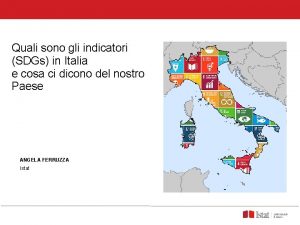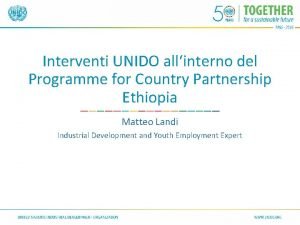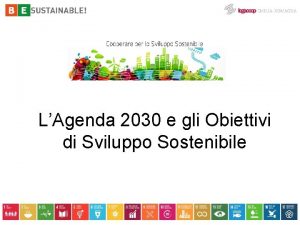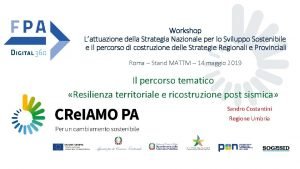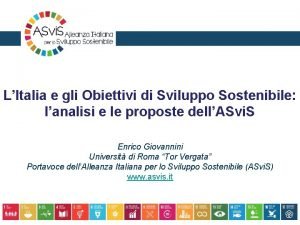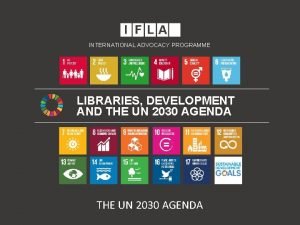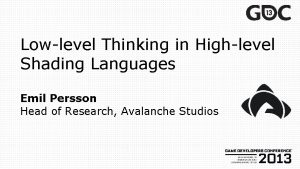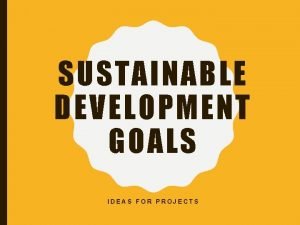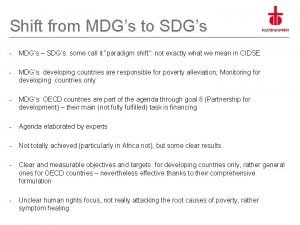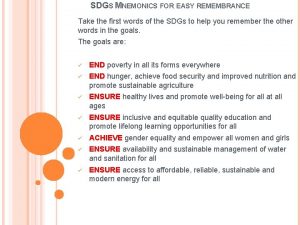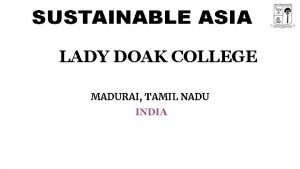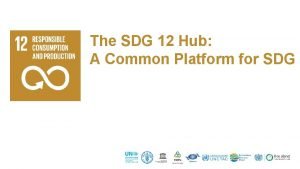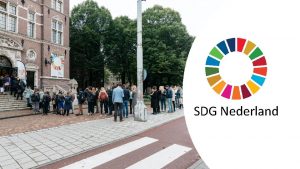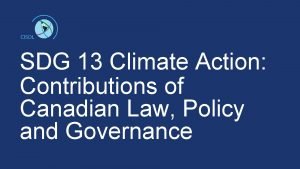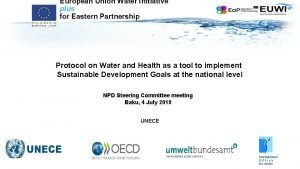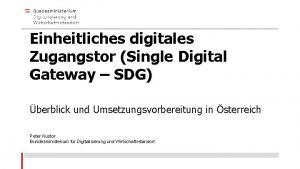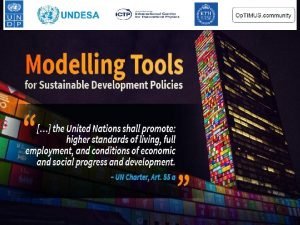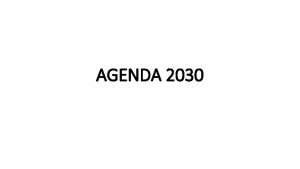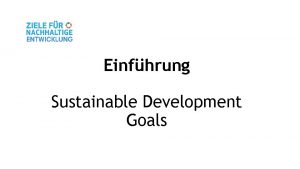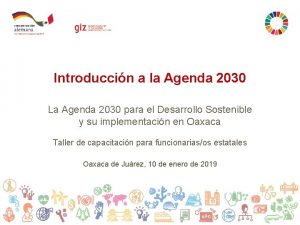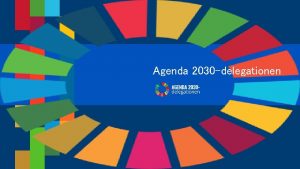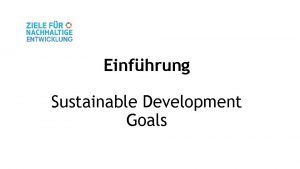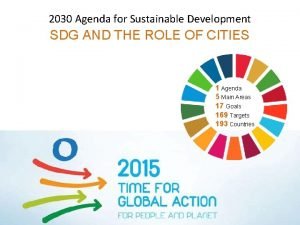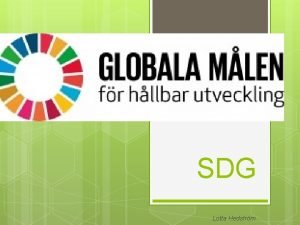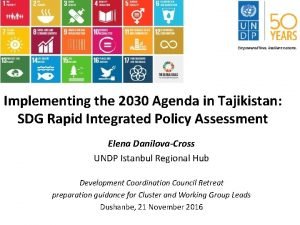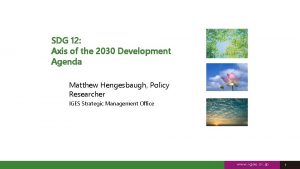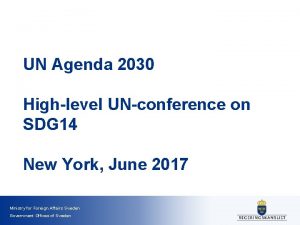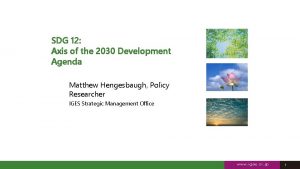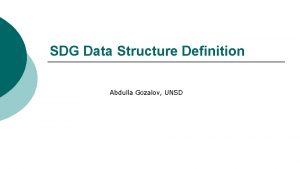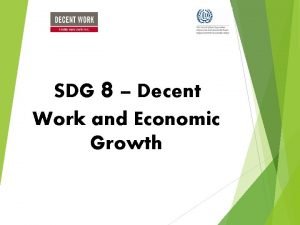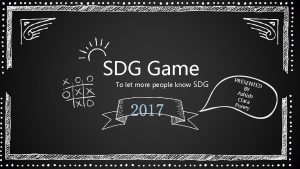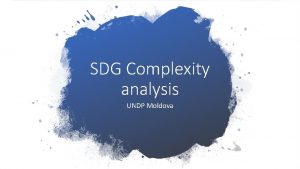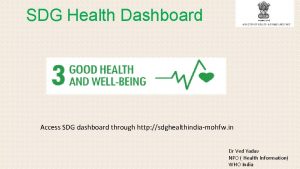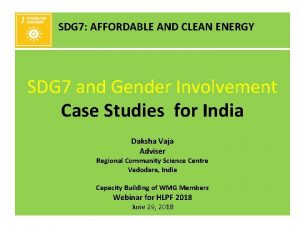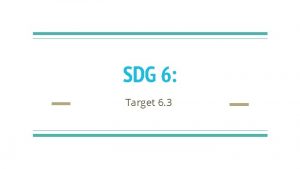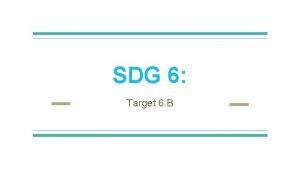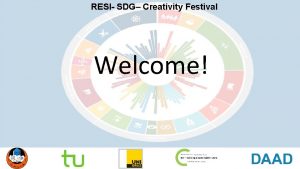HLPF ECOSOC High Level Interinstitutional 2030 Agenda SDG





























- Slides: 29


HLPF - ECOSOC High Level Inter-institutional 2030 Agenda & SDG Commission Simón Gaviria Muñoz Minister of Planning @simongaviria Simon. Gaviria. M New York, July 20, 2016

AGENDA 1. THE 2030 AGENDA AND THE SDGS FOR COLOMBIA 2. EARLY ACTIONS AND PROGRESS 3. A FIRST NATIONAL REVIEW OF THE SDGS IN COLOMBIA

AGENDA 1 THE 2030 AGENDA AND THE SDGs FOR COLOMBIA

COLOMBIA COMMITTED WITH 2030 AGENDA SINCE ITS INCEPTION INTERNATIONAL LEVEL Colombia active & constructive participation in: • Rio+20 • Secretary General post-2015 High Level Panel • Open Working Group on SDG • Intergovernmental Negotiations on the Post 2015 Development Agenda • IAEG-SDG NATIONAL LEVEL JUNE 2014: Allignment between Agenda 2030 & National Development Plan FEBRUARY 2015: Creation High Level Inter-institutional Commission BOTTOM-UP APPROACH: NDP created through a participatory process: 33 Regional Meetings, 27 Sectoral Dialogues, 7. 000 participants. Regional Dialogues for Sustainable Development in 7 cities covering all regions. Support from IADB, UNDP and Private Sector.

ALIGNMENT: 2030 AGENDA AND THE NDP 2014 -2018 “TODOS POR UN NUEVO PAÍS” NATIONAL DEVELOPMENT PLAN 2030 AGENDA Social Mobility Security and justice for peacebuilding PEACE EQUITY Green Growth Strategic competitiveness and infrastructure EDUCATION Rural Transformation Good Governance 111 of 169 targets in planning instruments: • 92 targets in NDP • 19 targets in other policy instruments

MULTI-STAKEHOLDER APPROACH EVERY SDG REQUIRES A MULTI-STAKEHOLDER APPROACH, RESPONSIBILITES ARE NONEXCLUDABLE 135 National Governments 88 34 Require active role or commitment from the Private Sector Global level as main scenario for action and implementation 169 TARGETS 110 Require actions by the Subnational Governments and multilevel coordination

INSTITUTIONAL FRAMEWORK: HIGH LEVEL INTER-INSTITUTIONAL COMMISSION 7 members (Cabinet level) PRESIDENT National Planning Department MEMBERS • National Planning Department (NPD) • Office of the President of the Republic • Ministry of Foreign Affairs (MRE) OTHER STAKEHOLDERS TECHNICAL SECRETARIAT National Planning Department Civil Society Private Sector Academia Media International community TECHNICAL COMMITTEE CROSS–SECTORAL WORKING GROUPS Indicators (DANE) Subnational (DNP) Resource mobilization (MHCP, PS, APC) Comunications (DNP) International Issues (MRE) • Ministry of Finance (MHCP) • Ministry of Environment (MADS) • Ministry of Social Prosperity (PS) • National Administrative Department of Statistics (DANE) • Permanent guest: Presidential Agency for International Cooperation (APC) Open to participation of other institutions of the national government

ONGOING PARTNERSHIPS PRIVATE SECTOR • Implement and surface concrete contributions to the SDGs Global Compact Network, Business Associations • Develop indicators to measure contribution of the Private Sector – based on existing initiatives, e. g. SDG Compass CONGRESS • Cross-party parliamentary group that actively participates in implementation and monitoring ACADEMIA • National knowledge network for sustainable development Initiative of Local Universities – based on the SDSN model CIVIL SOCIETY • Special annual sessions at the SDG Commission for discussion and accountability with stakeholders

AGENDA 2 EARLY ACTIONS AND PROGRESS

2030 AGENDA & THE SDGs AS A LONG-TERM ENVELOPING AND INTEGRATING TOOL ACTIVE NATIONAL AGENDAS DETERMINE ACTIONS RELATED TO AT LEAST 146 SDG TARGETS - 86% SDG NDP OECD ACCESSION GREEN GROWTH SDG TARGETS 92: NDP 2014 -2018 87: OECD 86: Green Growth Strategy 50: Peace Agreements PEACE BUILDING

ALIGNMENT: SDGs AND SUBNATIONAL DEVELOPMENT PLANS 63 SUBNATIONAL DEVELOPMENT PLANS (SDPs) – 2016/2019 • 100% of Local Development Plans included SDGs in policy framework • 32 Regional: high (7), medium (15) and broad (10) • 31 Main Cities: high (8), medium (9) and broad (14) • On average, SDPs include 30% of SDG targets in which subnational governments have shared responsibility (33/110) REGIONAL DEVELOPMENT PLANS High 22% MAIN CITIES DEVELOPMENT PLANS High 26% Medium 29% Medium 47% Broad 31% Broad 45% Source: NPD, 2016

ALIGNMENT: SDGs & SUBNATIONAL DEVELOPMENT PLANS 2016 -2019 63 60 SDP 50 40 30 63 62 62 62 61 60 56 56 52 43 40 35 34 34 21 20 10 4 0 Source: NPD, 2016

ALIGNMENT: SDGs & REGIONAL DEVELOPMENT PLANS 2016 -2019: GOVERNMENT OF NARIÑO THE RDP “NARIÑO, CORAZÓN DEL MUNDO” INCLUDES 35% OF SDGS TARGETS IN WHICH SUBNATIONAL GOVERNMENTS HAVE SHARED RESPONSABILITY WITH OTHER RELEVANT ACTORS (39/110) Strategic Axis: Equity and Social Inclusion Subprogram Specific Objectives Housing for Good Living Source: Adapted from RDP “Nariño Corazón del Mundo”, p. 16, 79 To reduce social housing deficit both in urban and rural areas of Nariño Outcome Goals Product Goals Baseline of households with quantitative housing deficit reduced in Nariño Social interest housing initiated in Nariño Alignment with SDG

AVAILABLE INFORMATION TO MEASURE GLOBAL INDICATORS 240 GLOBAL INDICATORS Information is available: 130 Partial information, need of improvements: 72 No data or methodology: 38 CHALLENGES • Frecuencies: 12, 4% of indicators have frecuencies above 1 year. • Disaggregations available for 55% of the 53 global indicators whose definitions include disaggregations

CHALLENGES FOR NATIONAL AGENDAS: HIGHLIGHTING NEW ISSUES AN EXAMPLE SDGs: AN OPPORTUNITY TO RAISE AWARENESS AND MOBILIZE THE POPULATION TO TAKE ACTION TARGET 12. 3 FOOD WASTE AND LOSSES In Colombia, 34% of food is either lost or wasted COLLECTIVE ACTION 58% of fruits and vegetables 49% of roots and tubers 15% of fish products 22% Is lost 8% of cereals 23% of dairy products 12% Is wasted 12% of meats Source: NPD, 2016 13% of grains

NATIONAL TARGET FOR 2030 TARGET 12. 3 FOOD WASTE AND LOSSES WASTE 22% of the food 10 p. p. reduction 2 p. p. reduction 3, 5 m. T of current losses and waste 2015 2030 =2, 8 m. T of current losses 2015 2030 =0, 7 m. T of current waste

2030 AGENDA & SDGs AS A LONG TERM REGULATORY FRAMEWORK 2016 2014 -2018 2030 NDP NDP 2018 -2022 -2026 -2030

SDGs AS A LONG TERM REGULATORY FRAMEWORK Example: Water And Sanitation WATER SERVICE COVERAGE SANITATION SERVICE COVERAGE 97% Urban 91% Urban 73% Rural 70% Rural SDG 6: ENSURE AVAILABILITY AND SUSTAINABLE MANAGEMENT OF WATER AND SANITATION FOR ALL Source: DANE.

REGULATION MEASURES AND INVESTMENT NEEDS Regulation Measures UNIVERSAL ACCESS Target 6. 1 • Strengthen subsidy allocation mechanisms • Alternative and differentiated schemes in rural areas with technical assistance to attain sustainability • Benchmarking and comparison among companies for continuous improvement in quality, continuity and coverage REGULATION Targets 6. 8 and 11. 1 • Balanced public and private benefits and improvement in service provision through contract regulation • Fusion of providers when studies indicate it necessary for improving coverage and lowering costs BIG DATA FOR SECTORAL INFORMATION Targets 6. 8 and 11. 1 FINANCING Target 6. 6 Implement information solutions for real-time monitoring of water & sanitation for decision-making Billions Universal coverages (100%) USD 7, 7 Sanitation coverage (100%) USD 4, 77 Wastewater treatment (50%) USD 0, 5 INVESTMENT DEFICIT USD 3 Insurance for replacement of infrastructure affected by natural disasters and climate-related events. Public and private investment requirements Calculations: National Planning Department

AGENDA 3 A FIRST NATIONAL REVIEW OF THE SDGS IN COLOMBIA

METHODOLOGY OF THE REPORT THIS FIRST NATIONAL REVIEW WILL FOCUS ON SDGs 1, 3, 8, 13 AND 17, AND ITS INTERLINKAGES WITH THE AIM OF: • Contributing to follow-up and review of the 2030 Agenda, respecting the integrated nature of the SDG and identifying key interlinkages among its goals and targets, in a balance among the economic, social and environmental dimensions, with a special emphasis on Gender Equality. • To review in greater depth the achievements, challenges, information gaps, and bottlenecks. • To promote exchange of experiences and mutual learning with other countries. • To serve as a basis for future national reviews.

SOCIAL DIMENSION: SDG 1 - NO POVERTY INCOME POVERTY (NATIONAL MEASURE) 40 37. 2 35 27. 8 30 25 20 15 12. 3 7. 9 10 5 0 2011 2012 Poverty 2013 2014 Extreme poverty MULTIDIMENSIONAL POVERTY 35 30. 4 30 25 20. 2 2015 ACHIEVEMENTS: Since 2010, 4. 6 million Colombians overcame poverty. National target set in the MDG framework (28, 5%) was met one year before the deadline. Today, 7, 9% of the Colombian population is in extreme poverty, down from 12, 3% in 2010. Trend is consistent with its eradication before 2030 (the national target for eradication is 2025) Multidimensional poverty by 2015 is 20, 2%, down from 30, 4% in 2010, representing over 4 million Colombians. 20 15 CHALLENGES: 10 Continue reducing gaps among regions. 05 00 2011 2012 2013 2014 2015 Accelerate reduction of inqualities. The Gini Coefficient was reduced to 0, 522 in 2015, from 0, 538 in 2014.

SOCIAL DIMENSION: SDG 3 - GOOD HEALTH AND WELLBEING CHILD AND MATERNAL HEALTH Maternal mortality per 100. 000 births reduced from 71, 64 in 2010 to 55, 25 in 2013. Reduction in child and neonatal mortality, from 2010 to 2014, from 21, 2 to 18, 81 and 7, 75 to 7, 24 respectively. SEXUAL AND REPRODUCTIVE HEALTH In 2010, 72, 9% of women between 15 and 49 age used family planning methods. In 2010, 19, 5% of teenage girls between 15 and 19 age is or has been pregnant. COMMUNICABLE AND NON COMMUNICABLE DISEASES Increase in tuberculosis incidence rate and new hepatitis infections between 2010 and 2015 Reduction in diabetes cases from 15, 49 in 2010 to 14, 60 in 2013 Increase in cancer mortality. In 2010 100, 92 to 101, 17 in 2013. Mortality rates from suicide stable between 2010 and 2014. HEALTH SYSTEM In 2015 historic high coverage 97, 58% of total population. Number of health workers per 1000 population increased. Medics: from 16 in 2010 to 19, 2 in 2015. Nurses: from 8, 6 in 2010 to 11, 5 in 2015.

ECONOMIC DIMENSION: SDG 8 - DECENT WORK AND ECONOMIC GROWTH ECONOMIC PERFORMANCE By 2015 3, 1% real growth. Second among large LAC countries, after Peru, conveys resilience to external shocks By 2014 2, 2% real growth per worker (productivity) Challenges: Diversification and new sources of growth, adopt sustainable consumption and production patterns EMPLOYMENT 2015 unemployment 8, 9%. Lowest in 15 years. Gender gap decreased from 6, 7 p. p to 5 p. p. Informal jobs: 49, 1% in 2015, down from 52, 8% in 2010. Gender gap grew from 5, 8 p. p to 6, 2 p. p. Challenges: Unemployment gaps (regions, women, youth, other relevant groups). Accelerate formalization. OTHER ISSUES Child labor in 2015: 9, 1%. Surpassed national target for 2015 set at 9, 3%. Adult population using at least one financial product increased to 70, 3%. Up 5, 5% from 2014.

ENVIRONMENTAL DIMENSION: SDG 13 - CLIMATE ACTION LOCAL DISASTER RISK REDUCTION STRATEGIES: Formulation of 2015 -2025 Disaster Risk Reduction National Plan. Between 2008 and 2015, 815 municipalities (73%) have formulated local Disaster Risk Reduction plans Between 2008 and 2015, 921 (83%) municipalities have engaged in capacity building for reducing deaths, missing and affected persons ABILITY TO ADAPT TO THE ADVERSE IMPACTS OF CLIMATE CHANGE, AND FOSTER CLIMATE RESILIENCE AND LOW GREENHOUSE GAS EMISSIONS DEVELOPMENT: In 2015, formulation and approval of National Plan of Adaptation to Climate Change March 2016: 78% of local planning instruments includes climate change and 11 localities have Adopted Adaptation Plans Sectoral level, 8 mitigation plans and 2 adaptation plans (transport and agriculture) have been formulated

SDG 17: PARTNERSHIPS FOR THE GOALS Implementation at the national level FINANCE • Structural tax reform ü Currently, taxes represent 17, 9% of GDP • Sustainable debt ü Debt service as % of exports - 5, 9% • Promotion and protection of investment • Public-Private Partnerships in provision of social services • Green bond strategy for climate change SYSTEMIC ISSUES • Policy coherence: Inter-institutional Commission for 2030 Agenda • Macroeconomic stability: Macroprudential regulations. Sound financial regulations • Multi-stakeholder approach to the national implementation of SDG TECHNOLOGY • Integration of National Science and Technology System with the Innovation System to enhance synergies and strengthen STI efforts. • Strengthened linkages between STI and productive capacities • Updating national policies to post-2015 era: Long-term STI Conpes document. DATA, MONITORING AND ACCOUNTABILITY • Big Data Strategy • SS Cooperation in data and statistics • National Statistics Plan and strategy for strengthening subnational capacities • Global Partnership for SD Data

CHALLENGES INTERLINKAGES AND INTEGRATED APPROACH LONG-TERM COHERENCE POSTCONFLICT AND PEACEBUILDING RESOURCE MOBILIZATION

THANK YOU
 Agenda 2030
Agenda 2030 Agenda 2030
Agenda 2030 Agenda 2030 geografia
Agenda 2030 geografia Agenda 2030 numero 15
Agenda 2030 numero 15 Territorial agenda 2030
Territorial agenda 2030 Consumo e produzione responsabile agenda 2030
Consumo e produzione responsabile agenda 2030 Italia agenda 2030
Italia agenda 2030 Agenda 2030 pl
Agenda 2030 pl Schema agenda 2030
Schema agenda 2030 International advocacy programme
International advocacy programme Agenda 2030
Agenda 2030 Agenda 2030
Agenda 2030 High level agenda
High level agenda Agenda sistemica y agenda institucional
Agenda sistemica y agenda institucional Rcp hlsl
Rcp hlsl Sdgs project ideas
Sdgs project ideas Why shift from mdg to sdg
Why shift from mdg to sdg Mnemonics for sdg
Mnemonics for sdg Sdg 11
Sdg 11 Sdg 12 hub
Sdg 12 hub Sdg nederland
Sdg nederland Sdg compass ejemplos
Sdg compass ejemplos Sdg
Sdg Sdg
Sdg Sdg 6
Sdg 6 Single digital gateway
Single digital gateway Gregory bateson framing theory
Gregory bateson framing theory Second level agenda setting
Second level agenda setting Parent meeting agenda for basketball
Parent meeting agenda for basketball High school freshman orientation agenda
High school freshman orientation agenda
